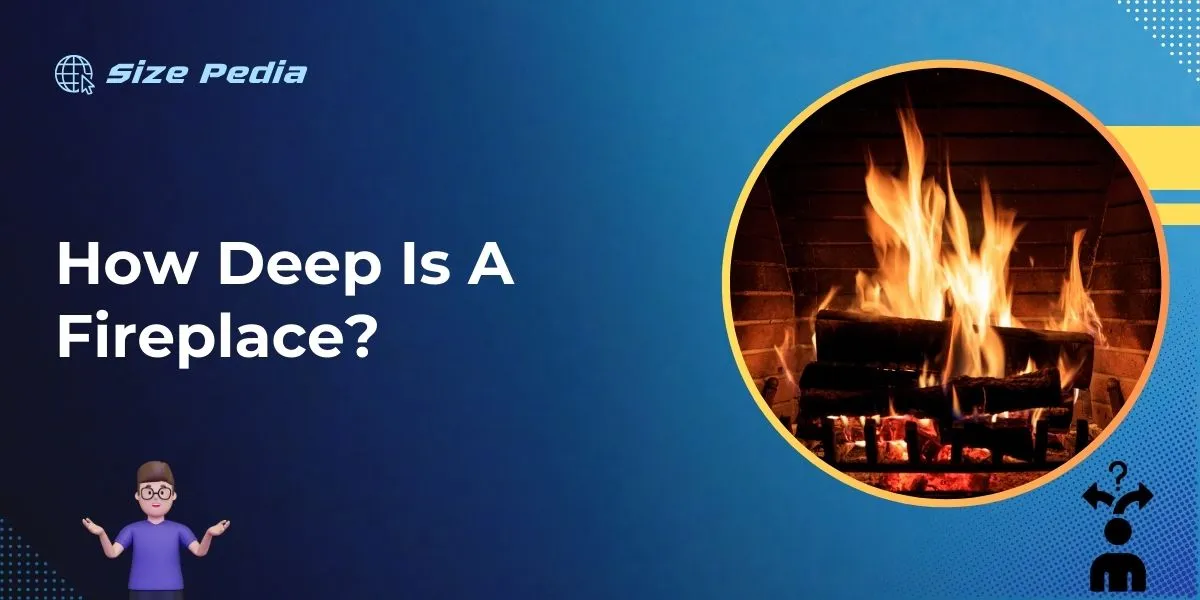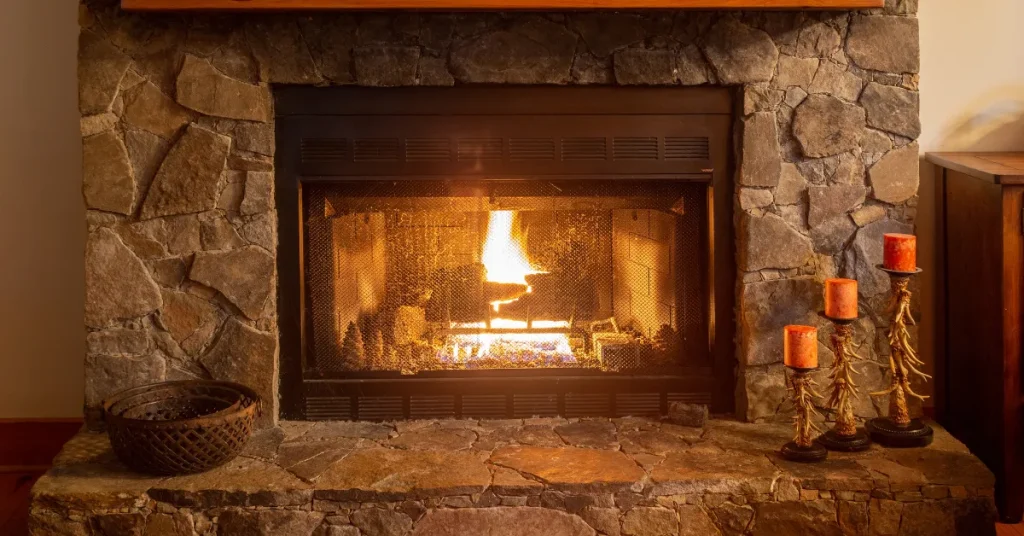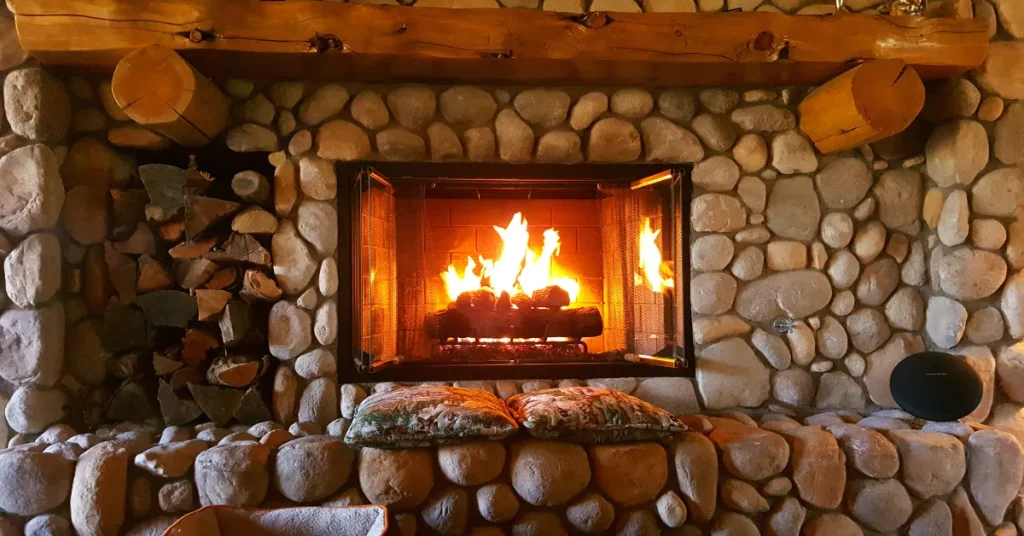The depth of a typical fireplace ranges from 16 to 20 inches. Standard dimensions are essential for efficient and safe fireplace operations.
Understanding the depth of a fireplace is crucial for proper installation, safety, and functionality. Building codes and guidelines dictate the necessary dimensions to ensure fireplaces operate correctly and are safe for users.
The depth of the fireplace influences factors such as how well it will draw and how much heat will radiate into the room.
Homeowners should consider these standards when opting for a new fireplace or renovating an existing one. Proper depth allows for the sufficient embers bed and facilitates good air flow, which contributes to an efficient burning process.
Utilizing the correct fireplace dimensions ensures a comforting ambiance without compromising safety or performance.

The Hearth Of The Home: Fireplace Dimensions Matter
Choosing the right fireplace involves more than style. Size matters for a cozy, safe home. It’s about warmth, charm, and the perfect fit. Let’s explore why depth is crucial for your fireplace.
Balancing Aesthetics And Function
Fireplaces shine as focal points in a room. Yet, their role is twofold:
- Beauty: They draw the eye and anchor interior design.
- Usage: They keep spaces warm and invite relaxation.
A deep enough fireplace holds logs safely, maintaining the flame’s dance. Too shallow, and you risk sparks escaping or logs rolling out.
A too-deep hearth might swallow the fire’s glow, lessening the ambiance. Both style and safety guide the best depth for a fireplace.
Industry Standards For Fireplace Depth
Depth is a key factor in fireplace design. It ensures the fire burns properly and safely. Here are standard measurements:
| Fireplace Type | Standard Depth |
| Wood-burning | 16-20 inches |
| Gas | 12-18 inches |
| Electric | Variable |
Remember, these depths are a starting point. Local building codes and the manufacturer’s specifications also play a part. Always tailor the depth for your home’s requirements and usage patterns. Check the manual for the best results.
Factors Influencing Fireplace Depth
Understanding the perfect fireplace depth involves several factors. Each has a big impact on design and function. Let’s explore key elements shaping this crucial feature.
Room Size And Layout
The size and design of a room guide fireplace depth. A well-proportioned fireplace brings warmth and beauty. It must fit the space without crowding.
- Large rooms can handle deeper fireplaces.
- Small spaces usually need shallower units to save room.
- Proper clearance around the fireplace ensures safety.
The layout helps decide the fireplace’s placement within the room.
Fuel Type Considerations
Different fuels need different fireplace depths.
| Fuel Type | Recommended Depth |
| Wood | 16-18 inches |
| Gas | 12-14 inches |
| Electric | 6-10 inches |
| Pellet | 14-16 inches |
Wood-burning fireplaces need more depth for logs. Gas and electric fireplaces may be shallower.
Types Of Fireplaces And Corresponding Depths

Discovering the perfect depth for a fireplace depends on its type. Each style suits different needs and spaces. Let’s dive into the world of fireplaces to explore how deep they should be.
Traditional Wood-burning Fireplaces
Traditional wood-burning fireplaces offer a classic touch to any home. Depth plays a crucial role in their design:
- Safety: Deeper fireboxes contain embers and sparks better.
- Efficiency: Proper depth ensures better heat distribution.
Common depths range from 16 to 24 inches.
| Fireplace Size | Recommended Depth |
| Small | 16 inches |
| Medium | 20 inches |
| Large | 24 inches |
Modern Gas And Electric Alternatives
Gas and electric fireplaces introduce contemporary elegance. Depth requirements differ because these units use different technology:
- Installation flexibility: Less depth needed for electric units.
- Ventless options: Gas units can be shallower as no chimney is needed.
Typical depths for modern alternatives can be as low as 6 inches for electric models, and 10 to 18 inches for gas fireplaces.
| Fireplace Type | Average Depth |
| Electric | 6 inches |
| Gas (Ventless) | 10 inches |
| Gas (Vented) | 14-18 inches |
Measuring Your Space For Fireplace Installation
Are you planning to install a fireplace? Measuring your space is crucial. The right fit ensures your fireplace not only looks perfect but functions safely and efficiently. Here’s how to measure your space correctly.
Tools And Techniques For Fireplace Measurement
Measuring for a fireplace is straightforward with the right tools. You’ll need:
- Tape measure: to get the length, width, and depth
- Level: to ensure everything sits straight
- Notepad: to jot down your figures
Follow these steps:
- Measure the width of the space where your fireplace will go.
- Record the height from the floor to the mantel or desired top point.
- Determine the depth for proper insert fitting.
Don’t forget to measure the mantel and any surrounding materials you’ll use.
Safety And Building Codes For Fireplace Installation
Appropriate depth for your fireplace is not just about aesthetics; it’s also about safety. You must know the building codes in your area.
These rules protect your home from fire hazards. They cover minimum distances from combustible materials and proper ventilation needs.
Always check:
- Local fireplace codes
- Clearance requirements for walls and mantels
- Proper ventilation regulations
Consult a professional if you’re unsure. They have the knowledge to guide you through the process safely.
Maximizing Your Fireplace’s Potential

The depth of your fireplace not only contributes to the aesthetic appeal but also to its heating efficiency. A well-proportioned fireplace depth enhances warmth distribution and safety.
Optimizing your fireplace’s depth offers a cozy ambiance and economic fuel use. Dive into accessorizing tips and maintenance practices to maximize your fireplace’s potential.
Accessorizing For Depth Enhancement
Choosing the right accessories can make a shallow hearth seem deeper and more inviting. Consider adding these elements:
- Fireplace Screens: A stylish screen adds depth perception while protecting against sparks.
- Log Holders: These frame the back of the fireplace, giving depth and character.
- Tool Sets: Position them to provide visual depth and practicality.
- Back Panels: Install decorative panels that create an illusion of depth.
| Accessory | Purpose | Depth Effect |
| Screens | Safety and Style | Increases perceived depth |
| Log Holders | Organization | Adds character and depth |
| Tool Sets | Utility | Enhances depth perception |
| Back Panels | Aesthetics | Creates illusion of depth |
Regular Maintenance For Optimal Performance
To ensure your fireplace works at its best, regular upkeep is crucial. Below are key maintenance tasks:
- Start with an annual inspection.
- Clean the chimney to prevent blockages.
- Remove ash after each use to maintain depth and air flow.
- Check for damage and repair promptly to safeguard depth integrity.
Clean fireplaces project more warmth and last longer. A well-kept hearth provides both safety and enhanced depth aesthetics.
FAQs About How Deep Is A Fireplace
What Is The Standard Depth Of A Fireplace?
The standard depth of a fireplace typically ranges from 16 to 24 inches. This dimension ensures adequate room for logs and proper heat output.
Does Fireplace Depth Affect Heating Efficiency?
Yes, fireplace depth can impact heating efficiency. Shallow fireplaces may reflect heat better into the room, while deeper ones contain larger fires but may require more fuel.
Can Fireplace Depth Be Customized?
Fireplace depth can be customized based on design preferences and safety regulations. However, it’s essential to adhere to building codes to ensure proper ventilation and function.
What Influences The Required Depth Of A Fireplace?
Factors such as the size of the room, type of fuel, and fireplace design influence the required depth. Larger rooms and wood-burning fireplaces may need greater depth for efficiency.
Conclusion
Understanding the depth of your fireplace is crucial for safety and efficiency. A well-sized fireplace enriches your home’s ambiance and heating capacity.
Remember, optimal depth varies by design and use. Consult professionals for tailored advice, ensuring your cozy fireside experiences remain secure and enjoyable.
Resources:
1. https://www.epa.gov/burnwise/choosing-right-fireplace-or-fireplace-retrofit-device
